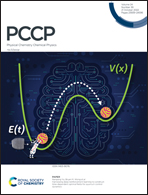Efficient direct conversion of methane into methanol on CuZn hetero-diatomic catalysts with certain coordination spheres: a DFT study†
Abstract
The oxidation of methane to a high-value-added chemical, methanol, is a major challenge in catalysis, requiring high energy input to overcome the CH3–H bond activation energy barrier. Based on density functional theory (DFT) calculations, methane oxidation to methanol is catalyzed by hetero-diatomic catalysts (CuZn-NG) with different coordination spheres (CSs). Valence band maximum (VBM), atomic charge and d-band center are selected as analysis methods for the pathway selection and activity of catalysis. The VBM plays a vital role in the catalytic pathway selection, CuZn-NG catalyzes the direct conversion of methane into methanol without side reactions. Alarmingly, the most important reaction step, CH3–H bond activation, is a spontaneously exothermic reaction (releasing 0.06 eV) with CuZn-NPAG as the catalyst, in contrast to most other endothermic reactions in the same activation. By analyzing the atomic charge of the Cu center and O atom, the special electronic phenomenon for this important step is summarized as the “bow-release effect”. The CS affects the electronic properties of the active center and further affects the methane oxidation activity. This work provides a useful guide to understand the catalytic selectivity and activity of hetero-diatomic catalysts.



 Please wait while we load your content...
Please wait while we load your content...